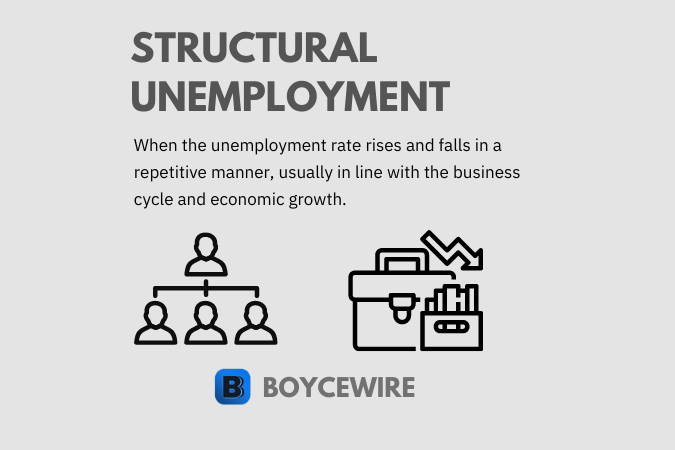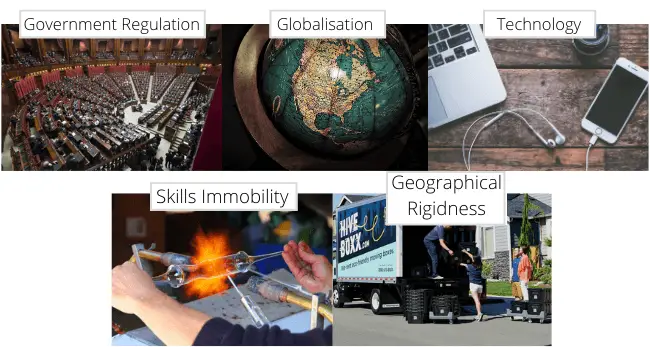Structural Unemployment: (Definition, 3 Causes & Example)

What is Structural Unemployment
Structural unemployment is where there is unemployment due to a change in the demand for specific skills and jobs. For instance, globalisation and technological advances have created structural unemployment in industries such as manufacturing.
Simply put, structural unemployment occurs because of changes in the economy. This might be because the job itself is no longer required, or the location of it moves. This is why it is referred to as ‘structural’. In essence, the structure of the economy changes.
Key Points
- Structural unemployment is a long-lasting shift that is caused by a change in the economic environment. This may be from globalisation or technological change.
- There is a mismatch between the skills offered and those demanded by employers.
- Unlike cyclical unemployment, it is caused by factors outside of the business cycle.
With technology advancing in leaps and bounds, structural unemployment has become a major concern for policymakers. Traditional ‘low-skilled’ jobs such as manufacturing, call-center jobs, and retail workers have all become victims of structural unemployment.
Economic advancement requires chaos in order to move forward. That means unemployment for many, but significant improvements in efficiency elsewhere. So whilst others benefit from the advances, there will be those ‘left behind’.
The left-behinds are those who have worked for years in a specific industry, only for it to be destroyed. As a result, they are left without work and no transferable skills. For instance, someone who has been manufacturing cars for 40 years is going to face a tough time finding work doing something else.
Causes of Structural Unemployment

Government Regulation
Changes to government regulations can potentially destroy industries. For instance, tightening restrictions on the use of fossil fuels will put pressure on oil and coal miners. Although new jobs may arise in industries such as renewable energy, those employees are not necessarily transferable.
In other words, someone who has worked as a miner for 20 years may not fit into an office-based job in the renewable energy market.
Such regulation has the ability to destroy industries. And although it may create new jobs, there is a fundamental shift between the skills previously required and those that are now required. In turn, we see structural unemployment. Those industries that are unable to legally function, or in a limited way, will have to reduce their staff and lay off workers.
Globalisation
Globalisation is one of the leading causes of structural unemployment today. The reduction in trade barriers and openness of countries across the world has led to supply chains developing from the US to China to Israel.
What has happened is that developed countries such as the US have shipped off jobs to cheaper developing nations such as India and China. For jobs such as manufacturing, the costs are a fraction of the price. At the same time, lower costs mean lower prices for the consumer. So the only party that loses are those affected by the change.
These are frequently referred to as those who are ‘left-behind’. In other words, the global economy has moved on, but they have been left behind. Everyone else is benefiting from lower costs, but they have been left without a job.
Globalisation has changed the structure of the economy and in its wake, created structural unemployment.
Geographical Rigidness
Geographical rigidness is where skilled workers are largely restricted by geographical factors. For instance, someone who works in software engineering may find their job is being offshored to India. They can either move or lose their job. In most cases, few Americans would be willing to move all that way, so would become a victim of structural unemployment.
Just to reiterate, the structure of the industry would have changed as jobs have been moved, which is why it is classed as ‘structural unemployment’.
Furthermore, the rigidity is enhanced by local ties. Even jobs that are transferred to a location in the same country may create structural unemployment. Someone in California may be unwilling to move to Seattle.
The reason? Well, there are many, but the main ones are ties to family and friends, as well as housing. We are human after all, so being close to family and friends is a priority for many. Uprooting and leaving is difficult. Even more so when there is a house to sell, move, and buy.
The very nature of buying property is to have it for life. However, it creates a rigid labour market. In turn, this only exasperates structural unemployment by restricting skilled labour from reaching its most efficient location.
Technology
Today we see technology like smartphones, laptops, and artificial intelligence (AI). However, technological advances go back hundreds and even thousands of years. The difference today is that its impact is more pronounced. Perhaps with the exception of the industrial revolution.
Back in the 19th century during the industrial revolution, advances in agriculture changed the world. It reduced the need for farmers as they became more efficient, leading to higher crop yields and lower prices. In turn, we saw structural unemployment rise.
Farmers went out of business, at least until new industries started opening. Those who farmed the land were now working in a factory. The structure of the economy had shifted.
In the same fashion today, artificial intelligent and other forms of technology are changing how we live and work. For some, this means their industry is destroyed, leaving them unemployed.
Skills Immobility
When the structure of the economy changes, there are demands for new skills, created by new industries. This means fewer factory workers and more programmers in today’s world.
The problem with this is that structural unemployment is created due to the difficulty in transitioning. Someone who has worked in a factory their whole life is going to find it difficult to learn a whole new trade.
At the same time, you have perhaps 50 or 60-year-old men and women who are going to find it difficult to get back into work. They need to learn new skills and new employers are more likely to offer employment to younger workers who will be more cost-effective to train up.
Effects of Structural Unemployment

Inequality
When the economy changes, so too does the distribution of income. It occurs every day as people are hired and fired. However, huge structural changes in the economy have equally huge effects on the distribution of income.
Whether it’s farmers from centuries ago, or manufacturers and retail outlets today, millions have been put out of work. When you combine this with the immobility of labour, both geographically and in terms of skills, you have a rigid labour market.
What this means is that those who are left structurally unemployed have little or no income. Perhaps they rely on government subsidies or their savings. Either way, their income level can fall dramatically, creating a higher risk of them falling into poverty.
Political Change
When structural unemployment puts a large proportion of the population out of the job, they react by voting. The most recent example of such was the election of President Donald Trump.
Lost manufacturing jobs helped contribute to Trump’s election in 2015 as millions rallied behind the America first rhetoric. The reason was simple. People had lost their jobs to cheaper labourers abroad. In turn, they wanted their jobs to return and Trump offered that.
When there are large swathes of people that have been made unemployed by structural change, a door opens to new political movements. We have seen this across the world with the Brexit vote, and the rise of far-left and right parties throughout Europe.
Reduced Participation and Underemployment
As structural change creates unemployment, many will have to either retrain or withdraw from the market. For someone who has worked in manufacturing for the last 30 years, it may be more appealing to take early retirement. In turn, they are completely removed from unemployment figures because they are no longer actively searching for employment.
This puts a downwards pressure on economic growth and output as workers who are capable are no longer adding to output. That is to say, more goods and services could be produced with their involvement.
This has happened on a large scale in America and is otherwise known as ‘underemployment’. It refers to the state by which those who are able to work are unwilling to. In statistical terms, they are not actively looking for unemployment so they are not considered as ‘unemployed’.
At the same time, you have those that are in roles that are unsuited to their qualifications. For instance, a law graduate working at McDonald’s. These are individuals that are able and willing to produce a higher level of output, but for one reason or another are unable too.
Structural Unemployment Example
Since 1990, global trade has grown leaps and bounds, with the value of global exports rising from under 15 percent to over 25 percent today. In turn, this has contributed to the off-shoring of domestic jobs to nations that offer cheaper production costs.
For instance, US manufacturing collapsed between 2000 and 2010. The number of manufacturing jobs in the United States, which had been relatively stable at 17 million since 1965, declined by one third in that decade, falling by 5.8 million to below 12 million in 2010.
The nature of manufacturing has changed. As machines have advanced, low-skilled labour in countries such as Mexico has become a hotbed for investment. Nations have opened up their borders to trade and manufacturing firms have entered.
As with the case of the US, Mexico offers not only cheaper labour, but access to cheaper inputs. In fact, Mexico has more free trade agreements with other nations than the US. That means goods such as steel, glass, aluminium, and other raw materials can come in at a lower cost.
To put this into perspective, Mexico has agreements with 50 other countries compared to the 20 that the US has. In turn, labour costs and input costs are cheaper, leading to reduce costs for the manufacturer and lower prices for the consumer. At the same time, this has caused widespread structural unemployment in the US.
Structural Unemployment Solutions

1. Education and Training
When the structure of the economy changes, so too does the demand for specific skills. In generations gone past, the only thing we needed was a pair of hands and commitment to hard labour. Whether harvesting the fields or mining coal, the necessary requirements were physical.
However, this has changed in today’s age. Gone are the days where two hands were enough to get a job. Now training and education are important aspects. We have to be able to analyse and use our minds more than before.
What we have seen is a transition from manual labour jobs towards more mentally intensive roles. That has contributed to structural unemployment as those who worked in the mines or factories become unemployed. If they are to be able to transition to the new world, they will need to be taught new skills that are demanded by employers.
Government programs are often touted as a solution, whilst employer-led apprenticeships and programs are also a potential solution. In fact, some employers offer on the job training, but it is difficult for older individuals to compete. Consequently, government programs may be a necessary requirement to help the older generation to adapt to the new economy.
2. Firm Subsidies
Another potential solution to structural unemployment is firm subsidies. Private firms may be unwilling to absorb the cost of having to train up an older employee. After all, it makes more sense to hire and train an 18-year-old that has 50 years’ employment ahead of them; rather than a 50-year-old that may retire in 10 years.
The problem faced is that those of an older generation are predominately affected by structural unemployment. Therefore, one potential solution is to offer private firms a financial incentive to hire such workers.
For instance, a business may receive $10k per year in subsidies for hiring an affected worker. This may come under conditions such as they have been unemployed for more than two years. Or, they were previously employed in one of the affected industries such as manufacturing.
3. Housing Subsidies
One of the main issues surrounding structural unemployment is the rigid nature of labour. New job opportunities are happening all over the world, as well as within the same country.
One solution is to offer housing subsidies between regions. For instance, the average resident in Alabama is going to find it difficult to afford a place in San Francisco or even anywhere else in California. In turn, it
makes it an impossible decision for those who have been made structurally unemployed to move.
Not only do housing subsidies make it more affordable to move to a new area, but they can also provide an incentive.
New jobs may in fact become available in poorer and less desirable areas. Or, more rural areas away from the cities. For instance, doctors are generally in high demand for small rural communities. The reason being is that they leave for big cities such as New York.
By offering housing subsidies, it has the potential to attract workers to areas that they would otherwise be unwilling to consider. After all, money is a great motivator.
Structural Unemployment FAQs
Structural unemployment is a type of unemployment which arises due to changes in the fabric of the economy. In other words, the demand for certain workers changes over time, which can create this type of unemployment. For example, many manufacturing workers have been left unemployment in developed nations such as the US – with jobs flooding to cheaper nations such as China.
The greatest cause of structural unemployment has been the seismic shift away from labour intensive jobs. Developed nations have seen the structure of their economics shift from ‘hands on’ work towards a more service based structure. Equally, in developing nations such as China, there has been a structural shift from rural work such as farming, towards industrial based employment in factories.
Since the global economy has open up to international trade, jobs have shifted from domestic markets to overseas. For example, manufacturing in developed nations such as the US has shifted to cheaper nations such as China. This has led to structural unemployment as the economic structure has shifted from such manufacturing jobs towards a more serviced based economy that we see today.
The main other types of unemployment are cyclical and frictional. Structural unemployment differs from these in the fact that there is an underlying factor which has fundamentally changed. Cyclical unemployment occurs in line with the ups and downs of economic growth, whilst frictional unemployment occurs as a result of the temporary transition between jobs. By contrast, structural unemployment is a much more long-term type of unemployment which occurs due to a fundamental change in the economy.
Structural unemployment is more difficult to address than other types of unemployment as it’s a fundamental issue with the economy. However, policymakers can look to address it by offering re-training and educational programs to help workers develop in line with the new structure of the economy. This may also include lowering the barriers for entrepreneurship and providing the tools to help those unemployed potentially start their own business. This might be through training programs or perhaps financial assistance and incentives.
About Paul
Paul Boyce is an economics editor with over 10 years experience in the industry. Currently working as a consultant within the financial services sector, Paul is the CEO and chief editor of BoyceWire. He has written publications for FEE, the Mises Institute, and many others.

Further Reading
 Balance Sheet: Definition, Format & Example - The balance sheet is a key financial statement that public and private companies report on. It highlights a firm's assets,…
Balance Sheet: Definition, Format & Example - The balance sheet is a key financial statement that public and private companies report on. It highlights a firm's assets,…  Monopolistic Competition: Characteristics & Examples - A market that has Monopolistic structure can be seen as a mixture between a monopoly and perfect competition. Whilst monopoly…
Monopolistic Competition: Characteristics & Examples - A market that has Monopolistic structure can be seen as a mixture between a monopoly and perfect competition. Whilst monopoly…  Pygmalion Effect: Definition, How it works & Example - The Pygmalion effect is where an individual’s performance is influenced by others’ expectations. In other words, higher expectations lead to…
Pygmalion Effect: Definition, How it works & Example - The Pygmalion effect is where an individual’s performance is influenced by others’ expectations. In other words, higher expectations lead to… 